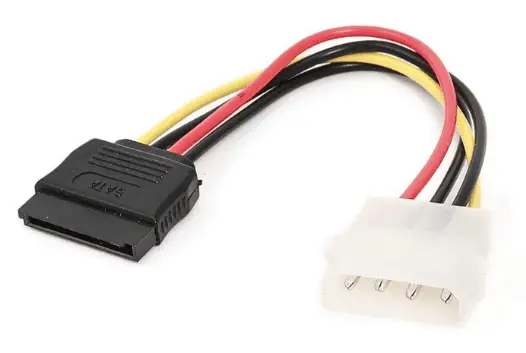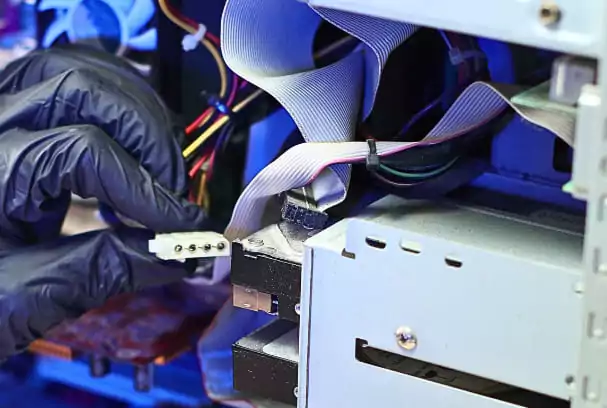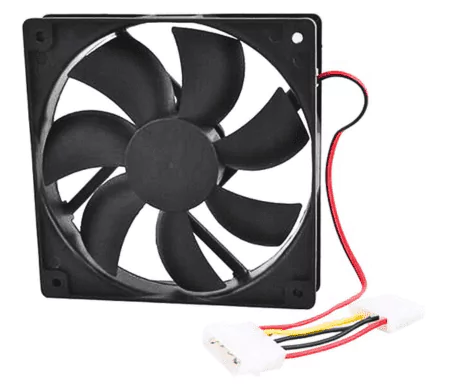The Molex connector is not used as much today but still exists on numerous PCs. In today’s post, I will review this 4-pin connector.
What is a Molex Connector?
A Molex connector, also known as a disk drive power connector, is a type of electrical connector that the Molex company originally developed in the late 1950s.
Molex connectors are known for their reliability, durability, and versatility. It consists of two main parts: a male connector (plug) and a female connector (socket) in order to fit with each other and establish a safe electrical connection. The connector body (where the Molex pinout is inserted into a Molex socket) usually has a flat shape and is made of nylon.
The number of contacts/pins can be from 2 to 24.
For the first time, the Molex connector was used to supply power to a floppy drive manufactured by Shugart.
Also, Molex connectors transmit only power but not data signals. Hence, the Molex cable connected to the connector carries power signals.
Popular Molex Connector Types
Among the myriad of Molex connectors available, first on the list is the Molex 8981 connector, somehow similar to standard 4-pin Molex connector. It’s not just its functionality that makes it familiar; its dimensions are quite distinct as well, with a width of 21 mm and height of 6 mm.
While both connectors serve similar purposes in providing power connections, they are not interchangeable due to their differences in design and pin arrangement.
Another heavyweight in the Molex lineup is the Molex Mini-Fit Jr connector. This connector is tailored for the motherboard, pumping up to 75 W of power through modifications with 20 and 24 contacts.
It’s a testament to Molex’s versatility, catering to a broad spectrum of requirements from video cards (older ones) and hard drives to CPU and other PC parts.
4 Pin Molex Connector
When we talk of Molex connectors, it’s impossible to ignore the iconic 4-pin connector variant that has powered computer components over the years.

This connector boasts a straightforward design consisting of color-coded wire pins that include the following:
- Yellow for 12 volts,
- Black for earthing,
- Red for 5 volts.
The arrangement ensures that even those with minimal technical knowledge can understand the basics of its operation.
It is used in various components like PATA hard drives, DVD/CD-ROMs, and even in old 3.5-inch floppy drives in my first PC case back in 2007, although all of these are now discontinued in market.
Its male and female connection design made it a staple in establishing secure and adequate power delivery across devices. However, it wasn’t without its quirks. The pins needed to be straight and firm, as a slightly bent pin could mean the difference between a smooth operation and frustrating connection attempts.
This typical issue became a thing of the past with the emergence of the SATA power connector, which provided a more streamlined and less error-prone connection experience.
Current status of Molex and its uses
While it’s true that the world of electronics is constantly evolving, Molex connectors have retained their relevance in specific areas despite facing competition from newer technologies. From my personal experience, I have observed that although these connectors are not as widespread as they once were.
At present, the transition towards SATA and PCIe connections for many electronic peripherals is apparent, offering a more compact and efficient alternative to Molex connectors.

The shift away from Molex can mainly be attributed to the decline of floppy drives, which were one of the primary devices used by these connectors.
Also, a connector known as the MATE-N-LOK was introduced to the market, providing a more versatile and cost-effective alternative for power delivery in various electronic devices.
However, Molex connectors, especially the 4-pin variants, haven’t completely disappeared from the scene. In many setups, you can find them powering RGB controllers and fans, showcasing their compatibility with both some contemporary and older hardware.
Therefore, haven’t you seen a SATA power Cable attached with 4 Pin Molex connector on the other end for connecting additional case fans? As in the above image.
Also, for projects involving legacy hardware or systems requiring a robust power connection, Molex connectors remain an option for such a DIY community to continue to leverage these connectors for custom builds and modifications.
It’s also worth mentioning that Molex connectors are still readily available for purchase in the market. This accessibility ensures that even as we move towards more efficient connection solutions, the option to utilize Molex remains open for those who prefer or require it.
What Is a Molex Connector Used For?
1. Computer Power Supplies
Computer’s nonmodular power supply units (PSU) frequently utilize 4-pin Molex connectors to power several key components such as fans, drives, and GPUs. Their design facilitates a consistent and reliable electricity supply, especially at high currents, which is essential for the optimal performance of computer internals.

2. Computer Fans
Molex connectors are often used for connecting additional case fans and coolers to power in both computers and servers. Moreover, you can use Molex connectors to power fan controllers, water pumps, and front panel modules. Their ability to provide both 12 and 5-volt power makes them indispensable in setups that require cooling units.

3. Old Hard Drives
The significance of Molex connectors extends back to the era of PATA (Parallel ATA) or IDE hard drives. Before the advent of Serial ATA (SATA 3) technology, these connectors were crucial in providing power to hard drives.
Since the SATA cable replaced PATA cable, the SATA power cable also superseded Molex power connector cable as the primary source of power for modern hard drives.
4. Industrial Equipment
Molex connectors’ robustness and reliability make them a preferred choice in the industrial sector. Their application spans a wide array of equipment, including machine tools, robotics, measuring systems and other business applications. The high reliability and ability to withstand harsh environmental conditions have cemented Molex connectors’ position in industries that demand uncompromising performance.
Despite modern alternatives, Molex connectors ensure they remain integral in the functioning of various industrial applications and circuit boards due to their enduring relevance and versatility.
Final Words
As I’ve explored, Molex connectors played a crucial role in the electronics world, from powering our computers to ensuring the smooth operation of industrial equipment. Their versatility and durability make them indispensable in a wide range of applications.
Although today, the relevance of Molex connectors has diminished in computers due to improvements in technology, their legacy continues.
Related Posts:
- What is GND on the Motherboard?
- What are the Front Panel Connectors on the Case?
- SATA vs NVMe » Comparison of Performance
- What is the Use of a USB Port on a Wi-Fi Router?
- TLC or TLC – Which Type of SSD Memory is Better to Choose?



